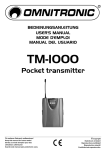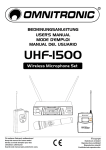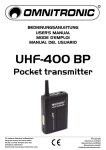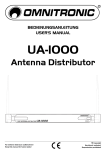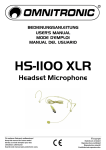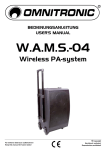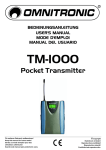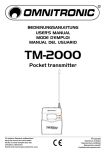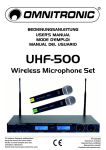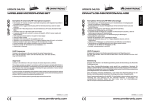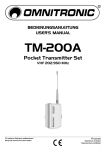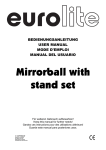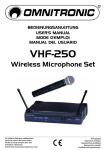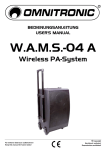Download TM-250
Transcript
BEDIENUNGSANLEITUNG USER'S MANUAL MODE D'EMPLOI MANUAL DEL USUARIO TM-250 Pocket transmitter VHF 224.250 VHF 230.250 VHF 211.700 VHF 237.700 Für weiteren Gebrauch aufbewahren! Keep this manual for future needs! Gardez ce mode d’emploi pour des utilisations ultérieures! Guarde este manual para posteriores usos. © Copyright Nachdruck verboten! Reproduction prohibited! Réproduction interdit! Prohibida toda reproducción. MULTI-LANGUAGE-INSTRUCTIONS Inhaltsverzeichnis/Table of contents Sommaire/Contenido 1. EINFÜHRUNG............................................................................................................................................... 3 2. SICHERHEITSHINWEISE............................................................................................................................. 4 3. BESTIMMUNGSGEMÄßE VERWENDUNG................................................................................................. 4 4. GERÄTEÜBERSICHT................................................................................................................................... 5 5. BEDIENUNG ................................................................................................................................................. 5 6. REINIGUNG UND WARTUNG...................................................................................................................... 6 7. TECHNISCHE DATEN .................................................................................................................................. 7 1. INTRODUCTION ........................................................................................................................................... 8 2. SAFETY INSTRUCTIONS ............................................................................................................................ 9 3. OPERATING DETERMINATIONS................................................................................................................ 9 4. DESCRIPTION OF THE DEVICE ............................................................................................................... 10 5. OPERATION ............................................................................................................................................... 11 6. CLEANING AND MAINTENANCE ............................................................................................................. 12 7. TECHNICAL SPECIFICATIONS................................................................................................................. 13 1. INTRODUCTION ......................................................................................................................................... 14 2. INSTRUCTIONS DE SÉCURITÉ ................................................................................................................ 15 3. EMPLOI SELON LES PRESCRIPTIONS................................................................................................... 15 4. DESCRIPTION DE L'APPAREIL................................................................................................................ 16 5. MANIEMENT ............................................................................................................................................... 16 6. NETTOYAGE ET MAINTENANCE ............................................................................................................. 17 7. CHARACTÉRISTIQUES TÉCHNIQUES .................................................................................................... 18 1. INTRODUCCIÓN......................................................................................................................................... 19 2. INSTRUCCIONES DE SEGURIDAD .......................................................................................................... 20 3. INSTRUCCIONES DE MANEJO ................................................................................................................ 20 4. VISTA GENERAL DEL APARATO ............................................................................................................ 21 5. OPERACIÓN ............................................................................................................................................... 21 6. LIMPIEZA Y MANTENIMIENTO ................................................................................................................. 22 7. ESPECIFICACIONES TÉCNICAS.............................................................................................................. 23 Das neueste Update dieser Bedienungsanleitung finden Sie im Internet unter: You can find the latest update of this user manual in the Internet under: Vous pouvez trouvez la dernière version de ce mode d'emploi dans l'Internet sous: Vd. puede encontrar la versión más reciente de este manual en el Internet bajo: www.omnitronic.com Diese Bedienungsanleitung gilt für die Artikelnummern This user manual is valid for the article numbers Ce mode d'emploi est concu pour les n° d'art. Este manual del usuario es válido para las referencias 2/23 13075005, 1307510, 1307512, 1307514 13075005, 1307510, 1307512, 1307514 13075005, 1307510, 1307512, 1307514 13075005, 1307510, 1307512, 1307514 13075005_V_1_0.DOC BEDIENUNGSANLEITUNG TM-250 Taschensender ACHTUNG! Gerät vor Tropf- oder Spritzwasser schützen! Nur vom Hersteller empfohlene Batterien verwenden! Lesen Sie vor der ersten Inbetriebnahme zur eigenen Sicherheit diese Bedienungsanleitung sorgfältig durch! Alle Personen, die mit der Aufstellung, Inbetriebnahme, Bedienung, Wartung und Instandhaltung dieses Gerätes zu tun haben, müssen - entsprechend qualifiziert sein - diese Bedienungsanleitung genau beachten - die Bedienungsanleitung als Teil des Produkts betrachten - die Bedienungsanleitung während der Lebensdauer des Produkts behalten - die Bedienungsanleitung an jeden nachfolgenden Besitzer oder Benutzer des Produkts weitergeben - sich die letzte Version der Anleitung im Internet herunter laden 1. EINFÜHRUNG Wir freuen uns, dass Sie sich für einen OMNITRONIC TM-250 Taschensender entschieden haben. Wenn Sie nachfolgende Hinweise beachten, sind wir sicher, dass Sie lange Zeit Freude an Ihrem Kauf haben werden. Nehmen Sie den OMNITRONIC TM-250 aus der Verpackung. Bitte überprüfen Sie vor der ersten Inbetriebnahme, ob kein offensichtlicher Transportschaden vorliegt. Sollten Sie Schäden entdecken, nehmen Sie das Gerät nicht in Betrieb und setzen sich bitte mit Ihrem Fachhändler in Verbindung. 1.1 Features Hochwertiger VHF-Taschensender • Zur qualitativ hochwertigen Gesangs- und Sprachabnahme für Bühne, Diskothek, öffentliche Reden, Theater etc. • Betrieb im anmeldepflichtigem VHF-Bereich • Für 224.250 / 230.250 / 211.700 / 237.700 MHz Festfrequenz • Mit On/Off/Mute-Betriebswahlschalter • Mit resonanzabsorbierender Beschichtung • Für 9V Blockbatterie • Mit LED-Anzeige der Batteriekapazität • Inkl. Headset und Lavalier-Mikrofon • 3,5 mm Klinke-Schraubverbindung zu Headset oder Lavalier Mikro 3/23 13075005_V_1_0.DOC 2. SICHERHEITSHINWEISE Dieses Gerät hat das Werk in sicherheitstechnisch einwandfreiem Zustand verlassen. Um diesen Zustand zu erhalten und einen gefahrlosen Betrieb sicherzustellen, muss der Anwender unbedingt die Sicherheitshinweise und die Warnvermerke beachten, die in dieser Gebrauchsanweisung enthalten sind. Unbedingt lesen: Bei Schäden, die durch Nichtbeachtung dieser Bedienungsanleitung verursacht werden, erlischt der Garantieanspruch. Für daraus resultierende Folgeschäden übernimmt der Hersteller keine Haftung. Halten Sie das Gerät von Hitzequellen wie Heizkörpern oder Heizlüftern fern. Das Gerät darf nicht in Betrieb genommen werden, nachdem es von einem kalten in einen warmen Raum gebracht wurde. Das dabei entstehende Kondenswasser kann unter Umständen Ihr Gerät zerstören. Lassen Sie das Gerät solange uneingeschaltet, bis es Zimmertemperatur erreicht hat! Beachten Sie bitte, dass Schäden, die durch manuelle Veränderungen an diesem Gerät verursacht werden, nicht unter den Garantieanspruch fallen. Kinder und Laien vom Gerät und der Batterie fern halten! 3. BESTIMMUNGSGEMÄßE VERWENDUNG Bei diesem Gerät handelt es sich um ein Taschensender für qualitativ hochwertige Gesangs- und Sprachabnahme. Dieses Produkt darf nur über einen Standard 9 V Block betrieben werden und wurde ausschließlich zur Verwendung in Innenräumen konzipiert. Zum Empfang der von dem Taschensender gesendeten Signale benötigen Sie einen Einzelantennen- oder Diversity-Empfänger mit der passenden Trägerfrequenz. Batterien sind Sondermüll und müssen als solche entsorgt werden. Soll das Gerät entsorgt werden, muss zuerst die Batterie entnommen werden. Die leeren Batterien können Sie fachgerecht im Elektrofachhandel in den dafür vorgesehenen Sammelbehältern entsorgen. Achten Sie beim Einlegen der Batterien auf die richtige Polung. Lassen Sie Batterien nicht offen herumliegen, es besteht die Gefahr, dass diese von Kindern oder Haustieren verschluckt werden. Suchen Sie im Falle eines Verschluckens sofort einen Arzt auf! Ausgelaufene oder beschädigte Batterien können bei Berührung mit der Haut Verätzungen verursachen, benutzen Sie deshalb in diesem Fall geeignete Schutzhandschuhe. Achten Sie darauf, dass die Batterien nicht kurzgeschlossen, nicht ins Feuer geworfen und nicht aufgeladen werden können. Es besteht Explosionsgefahr. Gießen Sie nie Flüssigkeiten über dem Gerät aus. Falls doch einmal Flüssigkeit in das Geräteinnere gelangen sollte, sofort die eingelegte Batterie entnehmen. Lassen Sie das Gerät von einem qualifizierten Servicetechniker prüfen, bevor es erneut benutzt wird. Beschädigungen, die durch Flüssigkeiten im Gerät hervorgerufen wurden, sind von der Garantie ausgeschlossen. Vermeiden Sie Erschütterungen und jegliche Gewaltanwendung bei der Inbetriebnahme des Gerätes. Betreiben Sie das Gerät nicht in extrem heißen (über 35° C) oder extrem kalten (unter 5° C) Umgebungen. Halten Sie das Gerät von direkter Sonneneinstrahlung (auch beim Transport in geschlossenen Wägen) und Heizkörpern fern. Lassen Sie das Gerät nicht von Personen bedienen, die sich nicht mit dem Gerät auskennen. Wenn Geräte nicht mehr korrekt funktionieren, ist das meist das Ergebnis von unsachgemäßer Bedienung! Reinigen Sie das Gerät niemals mit Lösungsmitteln oder scharfen Reinigungsmitteln, sondern verwenden Sie ein weiches und angefeuchtetes Tuch. 4/23 13075005_V_1_0.DOC Soll das Gerät transportiert werden, verwenden Sie bitte die Originalverpackung, um Transportschäden zu vermeiden. Beachten Sie bitte, dass eigenmächtige Veränderungen an dem Gerät aus Sicherheitsgründen verboten sind. Wird das Gerät anders verwendet als in dieser Bedienungsanleitung beschrieben, kann dies zu Schäden am Produkt führen und der Garantieanspruch erlischt. 3.1 Zulassung Diese Drahtlos-Mikrofonanlage wurde gemäß den europäischen Standards EN 300422-2, EN 301489-09 und EN 60065 geprüft. Dieses Produkt entspricht somit der R&TTE-Richtlinie der Europäischen Union und benötigt deshalb keine Einzel-EG-Baumusterprüfung jedes Mitgliedslandes. Für den Betrieb dieser Drahtlos-Mikrofonanlage in der Bundesrepublik Deutschland muss der Anwender eine Einzelfrequenzzuteilung bei der Bundesnetzagentur für Elektrizität, Gas, Telekommunikation, Post und Eisenbahnen (www.bundesnetzagentur.de) beantragen. Anträge und Ausfüllhinweise für Kurzzeitnutzungen (Sportveranstaltungen, Kulturereignisse, Messen, ...): Personen und Firmen mit Wohn-/Firmensitz in Deutschland wenden sich an die für den Veranstaltungsort zuständige Außenstelle der Bundesnetzagentur. Welche Außenstelle zuständig ist können Sie hier erfahren: http://www.bundesnetzagentur.de/enid/724e9dfb878312fc205b0790c430f059,0/Ueber_die_Agentur/Au_enst ellen_3z.html Einen direkten Link zum Antrag auf Kurzzeitnutzung finden Sie unter http://www.bundesnetzagentur.de/enid/371717457c6c967f23d7f8744cc3c7d5,d0d2d85f7472636964092d09 36333139/Frequenzzuteilung__Antraege_und_Ausfuellhinweise_/Kurzzeitnutzungen_d9.html Einen direkten Link zum Antragsformular für Durchsagefunk (Drahtlose Mikrofone etc.) finden Sie unter http://www.bundesnetzagentur.de/enid/724e9dfb878312fc205b0790c430f059,0/Frequenzordnung/Allgemein zuteilungen_9u.html Für den Betrieb in einem anderen Land kann es notwendig sein, eine Zulassung bei den Behörden zu beantragen. Bitte kontaktieren Sie die entsprechende Behörde und beantragen Sie eine solche Zulassung. Eine Behördenliste finden Sie im englischen Teil dieser Bedienungsanleitung unter Kapitel 3.1 Approval. 4. GERÄTEÜBERSICHT 1. Mikrofon-Eingangsbuchse 2. Sensivity-Regler 3. Batterie-LED 4. Betriebswahlschalter (ON/MUTE/OFF) 5. Batteriefach 5/23 13075005_V_1_0.DOC 5. BEDIENUNG 5.1 Einlegen/Wechseln der Batterien Bitte beachten Sie auch die Hinweise unter Bestimmungsgemäße Verwendung. Wird eine verbrauchte Batterie ausgetauscht, entfernen Sie zunächst die verbrauchte Batterie aus dem Batteriefach. ACHTUNG! Explosionsgefahr bei unsachgemäßem Auswechseln der Batterien. Nur durch denselben oder einen entsprechenden, vom Hersteller empfohlenen Typ ersetzen. Verbrauchte Batterien nach den Anweisungen des Herstellers beseitigen. Legen Sie die Batterien (Standard 9 V Block) ein und achten Sie auf die richtige Polung. Im Interesse einer langen Batterielebensdauer sollten nur Alkaline-Typen verwendet werden. ENTSORGUNGSHINWEIS Alte und verbrauchte Batterien bitte fachgerecht entsorgen. Diese gehören nicht in den Hausmüll! Bitte bei einer Sammelstelle in Ihrer Nähe abgeben 5.2 Inbetriebnahme Stecken Sie die Mikrofonleitung des Lavalier- oder Kopfbügelmikrofons in die Mikrofon-Anschlussbuchse. Befestigen Sie den Taschensender über die Gürtelspange am Gürtel oder Hosen-/Rockbund. Über den Betriebswahlschalter (ON/MUTE/OFF) lässt sich das Gerät ein- bzw. ausschalten. Beim Einschalten leuchtet die ON-LED kurz auf. In diesem Fall ist die Spannungsversorgung ausreichend. Bei schwächer werdender Batterie leuchtet die LED permanent. In diesem Fall muss die Batterie ausgetauscht werden (s.o.). Leuchtet die LED beim Einschalten gar nicht auf, ist entweder keine Batterie eingelegt oder die Polung ist nicht korrekt. Schalten Sie den Taschensender über den Betriebswahlschalter ab wenn er nicht verwendet wird. Bei längerer Nichtbenutzung entnehmen Sie bitte die Batterien, um ein Auslaufen zu verhindern. Wenn der Signaleingang am Receiver zu hoch ist, können Sie die Signalausgangsstärke über die Sensitivity-Einstellung absenken: Drehen Sie mit einem Schraubendreher am Sensitivity-Regler, bis die gewünschte Ausgangsstärke erreicht ist. 6/23 13075005_V_1_0.DOC 6. REINIGUNG UND WARTUNG Das Gerät sollte regelmäßig von Verunreinigungen wie Staub usw. gereinigt werden. Verwenden Sie zur Reinigung ein fusselfreies, angefeuchtetes Tuch. Auf keinen Fall Alkohol oder irgendwelche Lösungsmittel zur Reinigung verwenden! Im Geräteinneren befinden sich außer der Batterie keine zu wartenden Teile. Wartungs- und Servicearbeiten sind ausschließlich dem autorisierten Fachhandel vorbehalten! Um die Batterie auszutauschen, beachten Sie bitte die Hinweise unter "Einlegen/Wechseln der Batterien". Sollten einmal Ersatzteile benötigt werden, verwenden Sie bitte nur Originalersatzteile. Sollten Sie noch weitere Fragen haben, steht Ihnen Ihr Fachhändler jederzeit gerne zur Verfügung. 7. TECHNISCHE DATEN Trägerfrequenz / Artikel: 13075005 TM-250 13075010 TM-250 13075012 TM-250 13075014 TM-250 Modulation: Frequenzstabilität: Schwellenwert: Audiobandbreite: Frequenzhub: RF Ausgangsleistung: Spannungsversorgung: Lebensdauer der Batterie: Audio Eingang: Maße (LxBxH): Gewicht: VHF 224.250 MHz VHF 230.250 MHz VHF 211.700 MHz VHF 237.700 MHz FM, F3F <± 30 ppm <0,5 % bei 1 KHz 40 - 15 kHz (± 3 dB) ± 25 kHz 8,5 mW 1 Standard 9 V Block ca. 6 Stunden 3,5 mm Klinke 106,5 x 64,5 x 31,5 mm 80 g Bitte beachten Sie: Technische Änderungen ohne vorherige Ankündigung und Irrtum vorbehalten. 01.02.2007 © 7/23 13075005_V_1_0.DOC OPERATING INSTRUCTIONS TM-250 Pocket transmitter CAUTION! Keep this device away from rain and moisture! Only use batteries recommended by the manufacturer! For your own safety, please read this user manual carefully before you initially start-up. Every person involved with the installation, operation and maintenance of this device has to - be qualified - follow the instructions of this manual - consider this manual to be part of the total product - keep this manual for the entire service life of the product - pass this manual on to every further owner or user of the product - download the latest version of the user manual from the Internet 1. INTRODUCTION Thank you for having chosen an OMNITRONIC TM-250 . If you follow the instructions given in this manual, we can assure you that you will enjoy this device for many years. Unpack your OMNITRONIC TM-250. Please make sure that there are no obvious transport damages. Should you notice any damage, do not take the device into operation and immediately consult your local dealer. 1.1 Features High-quality VHF pocket transmitter • Provides high-quality vocal and voice pickup for stages, discotheques, public speaking, theater etc. • Operation in the VHF-band • Fixed frequency: 224.250 / 230.250 / 211.700 or 237.700 MHz • With On/Off/Mute operation selector • With resonance absorbing coating • For 9 V battery • LED-display with battery capacity • With EC type approval certificate • Incl. headset and lavalier microphone • 3.5 mm jack-screw connection to headset or lavalier mic 8/23 13075005_V_1_0.DOC 2. SAFETY INSTRUCTIONS This device has left our premises in absolutely perfect condition. In order to maintain this condition and to ensure a safe operation, it is absolutely necessary for the user to follow the safety instructions and warning notes written in this user manual. Important: Damages caused by the disregard of this user manual are not subject to warranty. The dealer will not accept liability for any resulting defects or problems. Keep away from heaters and other heating sources! If the device has been exposed to drastic temperature fluctuation (e.g. after transportation), do not switch it on immediately. The arising condensation water might damage your device. Leave the device switched off until it has reached room temperature. Please note that damages caused by manual modifications on the device or unauthorized operation by unqualified persons are not subject to warranty. Keep away children and amateurs from the device and the battery! 3. OPERATING DETERMINATIONS This device is a pocket transmitter for high-quality vocal and voice pickup. This product is only allowed to be operated with a 9 V Alkaline battery and was designed for indoor use only. In order to receive the transmitted signals, you need a single antenna receiver or Diversity-receiver with the suitable carrier frequency. Batteries are hazardous waste which need to be disposed of appropriately. If the device is to be disposed, the battery has to be removed first. Make sure that the poles are correct when inserting the battery. Never let batteries lying around openly as there is the danger that these can be swallowed by children or domestic animals. Immediately consult a doctor when batteries are swallowed! Leaking or damaged batteries can cause irritations when getting into contact with the skin. In this case use appropriate protective gloves. Make sure that the battery cannot be short-circuited, thrown into the fire and be charged. There is a danger of explosion. Never spill any liquids on the device. Should any liquid enter the device nevertheless, remove the battery immediately. Please let the device be checked by a qualified service technician before you operate it again. Any damages caused by liquids having entered the device are not subject to warranty! Do not shake the device. Avoid brute force when operating the device. Do not operate the device in extremely hot (more than 30° C) or extremely cold (less than 5° C) surroundings. Keep away from direct insulation (particularly in cars) and heaters. Do not permit operation by persons not qualified for operating the device. Most damages are the result of unprofessional operation! Never use solvents or aggressive detergents in order to clean the device! Rather use a soft and damp cloth. Please use the original packaging if the device is to be transported. Please consider that unauthorized modifications on the device are forbidden due to safety reasons! 9/23 13075005_V_1_0.DOC If this device will be operated in any way different to the one described in this manual, the product may suffer damages and the guarantee becomes void. 3.1 Approval This wireless microphone system was tested in accordance with the European standards EN 300422-2, EN 301489-09 and EN 60065. Consequently, this product adheres to the R&TTE-Directive of the European Union and does not need an individual EC type examination of every member state. In some countries, the operation of this wireless microphone system needs to be approved by your telecoms regulatory authority. Please refer to your authority as listed below: Telecoms & Postal Regulatory Authorities in Europe Austria Rundfunk und Telekom Regulierungs-GmbH www.rtr.at Belgium Belgian Institute of postal services and telecommunications (BIPT) www.bipt.be Czech Republic Czech Telecommunication Office www.ctu.cz Denmark National Telecom Agency www.tst.dk Finnland Finnish Communications Regulatory Authority (FICORA) www.ficora.fi France Autorité de Régulation des Télécommunications (ART) www.art-telecom.fr Greece National Telecommunications Commission (EET) www.eett.gr Hungary Communication Authority (HIF) www.hif.hu Iceland Post and Telecom Administration (PTA) www.pta.is Ireland Commission for Communications Regulation (ComReg) www.comreg.ie Italy Italian Communications Authority (AGC) www.agcom.it Latvia Telecommunication State Inspection www.vei.lv Liechtenstein Office for Communications (AK) www.ak.li Lithuania Radio Administration www.rrt.lt Luxembourg Institut Luxembourgeois des Télécommunications (ILT) www.etat.lu/ILT Netherlands Onafhankelijke Post en Telecommunicatie Autoriteit (OPTA) www.opta.nl Agentschap Telecom www.agentschap-telecom.nl Ministry of Economic Affairs www.ez.nl Norway Norwegian Post and Telecommunications Authority (NPT) www.npt.no Poland Urzad Regulacji Telekomunikacji (URT) www.urt.gov.pl Portugal Autoridad Nacional De Comunicaçòes (ICP-Anacom) www.anacom.pt Slovenia Agencija za telekomunikacije, radiodifuzijo in pošto www.atrp.si Spain Comisión del Mercado de las Telecomunicaçiones (CMT) www.cmt.es Sweden National Post and Telecom Agency (PTS) www.pts.se Switzerland Federal Office for Communications www.bakom.ch UK Office of Telecommunications (Oftel) www.oftel.gov.uk Postal Services Commission (Postcomm) www.postcomm.gov.uk/ Radiocommunications Agency www.open.gov.uk/radiocom 10/23 Telecoms & Postal Regulatory Authorities in the Rest of the World Argentina Comisión Nacional de Comunicaciones (CNC) www.cnc.gov.ar Australia Department of Communications, Information Technology and the Arts www.dca.gov.au Brazil Anatel www.anatel.gov.br Canada Canadian Radiotelevision and Telecommunications Commission (CRTC) www.crtc.gc.ca Colombia Ministerio de Comunicaciones www.mincomunicaciones.gov.co Hong Kong Office of the Telecommunications Authority (OFTA) www.ofta.gov.hk Japan Ministry of Public Management, Home Affairs, Posts and Telecommunications www.soumu.go.jp Korea Ministry of Information and Communication (MIC) www.mic.go.kr Mexico Secretaría de Comunicaçiones y Transportes (SCT) www.sct.gob.mx Taiwan Ministry of Transportation and Communications (MOTC) www.motc.gov.tw/welcome.htm Thailand Post and Telegraph Department (PTD) www.ptd.go.th USA Federal Communications Commission (FCC) www.fcc.gov Postal Rate Commission (PRC) www.prc.gov 13075005_V_1_0.DOC 4. DESCRIPTION OF THE DEVICE 1. Microphone input socket 2. Sensivity-Control 3. Battery LED 4. Operation selector (ON/MUTE/OFF) 5. Battery compartment 5. OPERATION 5.1 Inserting/Replacing the batteries Please refer to the explanations under Operating Determinations. If replacing the batteries, remove the old batteries from the battery compartment. Caution! Danger of explosion when battery is replaced improperly. Only replace by the same type or similar types recommended by the manufacturer. Remove empty battery in accordance with the instructions of the manufacturer. Insert a 9 V Alkaline battery and make sure that the poles are correct. In order to have a long battery life, you should only use alcaline batteries. BATTERY DISPOSAL NOTICE Please dispose of old and used batteries properly. Batteries are hazardous waste and should not be disposed of with regular domestic waste! Please take old and used batteries to a collection center near you. 11/23 13075005_V_1_0.DOC 5.2 Start-up Screw the microphone lead into the microphone input socket. Attach the pocket transmitter via the belt clip to the belt or waistband. With the operation selector, you can switch the device on and off. When switching the device on, the LED shortly lights up. In this case, the power supply is sufficient. When the battery is getting weaker, the LED is permanently illuminated. In this case, the batteries have to be replaced. If the LED does not light up when switching on, there is either no battery inserted or the poles are wrong. If the signal-input at the receiver is too high, you can attenuate the signal output level via the Sensitivityselection: use a screwdriver in order to turn the control until the desired sensitivity is adjusted. If the device is not used, switch it off. If the device will not be used for a longer period of time, remove the batteries in order to avoid battery leakage. 6. CLEANING AND MAINTENANCE We recommend a frequent cleaning of the device. Please use a soft lint-free and moistened cloth. Never use alcohol or solvents! There are no servicable parts inside the device except for the battery. Maintenance and service operations are only to be carried out by authorized dealers. In order to replace the battery please refer to "Inserting/exchanging batteries". Should you need any spare parts, please use genuine parts. Should you have further questions, please contact your dealer. 12/23 13075005_V_1_0.DOC 7. TECHNICAL SPECIFICATIONS Carrier frequency / Article: 13075005 TM-250 13075010 TM-250 13075012 TM-250 13075014 TM-250 Modulation: Frequency stability: T.H.D.: Audio bandwidth: Maximum deviation: RF power output: Power supply: Battery life: Audio input: Dimensions (LxWxH): Weight: VHF 224.250 MHz VHF 230.250 MHz VHF 211.700 MHz VHF 237.700 MHz FM, F3F <± 30 ppm <0.5 % at 1 KHz 40 - 15 kHz (± 3 dB) ± 25 kHz 8.5 mW 1 standard 9 V battery approx. 6 hours 3.5 mm jack 106.5 x 64.5 x 31.5 mm 80 g Please note: Every information is subject to change without prior notice. 01.02.2007 © 13/23 13075005_V_1_0.DOC MODE D'EMPLOI TM-250 Émetteur de poche ATTENTION! Protéger de l'humidité. Seulement utiliser des piles recommandées par le fabricant! Pour votre propre sécurité, veuillez lire ce mode d'emploi avec attention avant la première mise en service. Toute personne ayant à faire avec le montage, la mise en marche, le maniement et l’entretien de cet appareil doit - être suffisamment qualifiée - suivre strictement les instructions de service suivantes - considérer ce mode d'emploi comme faisant partie de l'appareil - conserver le mode d'emploi pendant la durée de vie de l'article - transmettre le mode d'emploi à un éventuel acheteur ou utilisateur de l'appareil - télécharger la version ultérieure du mode d'emploi d'Internet 1. INTRODUCTION Nous vous remercions d'avoir choisi un OMNITRONIC TM-250. Si vous respectez les instructions de service suivantes, vous allez profiter longtemps de votre achat. Sortez l'OMNITRONIC TM-250 de son emballage. Avant tout, assurez-vous que l'appareil n'a pas subi de dommages lors de son transport. Si tel était le cas, contactez immédiatement votre revendeur. 1.1. Features Émetteur de poche compacte • Pour transmettre les signaux du microphone au récepteur • Maniement sur bande VHF • Fréquence fixe: 224.250 / 230.250 / 211.700 ou 237.700 MHz • Pour 1 standard 9 V bloc • Avec affichage DEL de la capacité de la pile • Avec sélecteur de fonctionnement (Off/On/Mute) • Sénsibilité du microphone ajustable grâce au régulateur Gain • Avec certificat européenne du modèle type • Microphone Lavalier et Headset inclus • Connexion grâce à douille jack 3,5 mm 14/23 13075005_V_1_0.DOC 2. INSTRUCTIONS DE SECURITE Cet appareil a quitté les ateliers dans un état irréprochable. Pour assurer un bon fonctionnement, sans danger, l'utilisateur doit suivre les instructions contenues dans ce mode d'emploi. Attention: Tout dommage occasionné par la non observation des instructions de montage ou d'utilisation n'est pas couvert par la garantie. Tenez l'appareil éloigné de toute source de chaleur. Lorsque l'appareil est transporté d'un endroit froid à un endroit chaud, il se forme de la condensation susceptible d'endommager les modules électroniques. Ne pas brancher l'appareil avant qu'il ait atteint la température ambiante. Tout dommage résultant d'une modification sur l'appareil n'est pas couvert par la garantie. Tenir les enfants et les novices éloignées de l'appareil et de la pile. 3. EMPLOI SELON LES PRESCRIPTIONS Cet appareil est un émetteur de poches pour une prise de son de chante et des voix de haute qualité. Cet appareil doit seulement être mis en service avec 1 standard 9 V bloc et a été conçu pour un usage dans des locaux clos. Pour recevoir les signaux émettés du émetteur de poche, vous avez besoin d'un récepteur à antenne unique ou récepteur Diversity avec la fréquence porteuse appropriée. Piles sont déchets dangereux et doivent être éliminées comme-ça. Quand vous élimiéz l'appareil la pile doit être retirée avant. Assurez-vous des pôles correctes quand insérer la pile. Ne laissez pas la pile librement, parce-ce qu'il consiste le danger que celle-ci sont déglutit par des enfants ou des animaux domestiques. Dans ce cas consultez un docteur toute de suite! Des piles dégénarées ou avariée peuvent causer cautérisations quand en contact avec la peau. Dans ce cas, utilisez des gants de protection. Prenez garde que les piles ne peuvent pas être court-circuitées, dardées au feu ou chargées. Il consiste risque d'explosion. Ne déposez jamais de liquide sur l'appareil. Si toutefois, du liquide devait s'infiltrer dans l'appareil, quiter la pile immédiatement, puis le faire vérifier par un technicien compétent avant de le réutiliser. Les dommages causés par l'infiltration de liquides ne sont pas couverts par la garantie. Eviter les secousses et l'emploi de force lors de l'utilisation de l'appareil. Ne pas utiliser l'appareil lorsque la température ambiante est supérieure à 35° C ou inférieure à 5° C. Ne pas exposer l'appareil directement aux rayons solaires (lors d'un transport dans un véhicule fermé par exemple). Ne laissez pas des personnes incompétentes utiliser cet appareil. La plupart des pannes survenant sur cet appareil sont dues à une utilisation inappropriée par des personnes incompétentes. Ne nettoyez pas l'appareil avec des produits de nettoyages trop puissants ou abrasifs. Utilisez un chiffon doux, humide. Si vous deviez transporter l'appareil, utilisez l'emballage d'origine pour éviter tout dommage. Notez que pour des raisons de sécurité, il est interdit d'entreprendre toutes modifications sur l'appareil. 15/23 13075005_V_1_0.DOC Si l'appareil est utilisé autrement que décrit dans ce mode d'emploi, ceci peut causer des dommages au produit et la garantie cesse alors. 3.1 Admission Dépendant du pays d'operation, cet appareil doit obtenir une admission des autorités. Svp, contactez votre autorité respective pour obtenir cette admission quand nécéssaire. Vous pouvez encontrer une liste des autorités sous la partie anglaise de cette mode d'emploi, chapitre 3.1 Approval. 4. DESCRIPTION DE L'APPAREIL 1. Douille d'entrée du microphone 2. Régulateur Sensivity 3. LED de la pile 4. Sélecteur de fonctionnement (ON/MUTE/OFF) 5. Compartement de la pile 5. MANIEMENT 5.1 Insérer/remplacer les piles Veuillez faire attention aux instructions sous Emploi selon les Prescriptions. Quand vous remplacez la pile, retirez la pile du compartement de pile avant. Attention! Risque d'explosion quand remplacer la pile incompétentement. Seuelement remplacer avec le même type ou un type recommandé par le fabricant. Écarter la pile usée après les instructions du fabricant. Insérez 1 standard 9 V bloc et assurez-vous des pôles correctes. Dans l'intérêt d'une vie durée de la pile seulement utiliser des piles de type alcaline. REMARQUES SUR LA GESTION DES DÉCHETS Écarter la pile usée d'après les instructions du fabricant. N' écarter jamais la pile usée en ordures ménagères! Porter la pile usée au point de collection dans votre région 16/23 13075005_V_1_0.DOC 5.2 Mise en service Vissez le câble de microphone du microphone Lavalier ou du micro-casque à la douille d'entrée du microphone. Fixez l'émetteur de poche via le clip de ceinture à la ceinture ou la bandoulière. Avec le sélecteur de fonctionnement, vous pouvez mettre l'appareil sous/hors ténsion. Quand mettre l'appareil sous tension, la DEL clignote brevement. Dans ce cas, aura l'alimentation électrique passable. Quand la pile est plus faible, la DEL brille permanentement. Dans ce cas, la pile doit être remplacée. Quand la DEL ne clignote pas de tout, il n'y a aucune pile ou la polarisation aura à l'envers. Quand l'entrée de signal au récepteur est trop élevée, vous pouvez accentuer la puissance de sortie de signal grâce à la sélection Sensitivity: utilisez un tournevis pour tournez le régulateur jusqu'à la sénsibilité désirée est ajustée. Mettez le microphone hors de service grâce au sélecteur de fonctionnement quand vous ne l'utilisez pas. Quand la présentation etc. est fini, choissisez la position OFF. En cas de non-maniement pour une periode longue, retirez la pile pour éviter une dégénaration de la pile. 6. NETTOYAGE ET MAINTENANCE L'appareil doit être nettoyée régulièrement. Utilisez un torchon non pelucheux humide. Ne pas utiliser de l’alcool ou des détergents pour le nettoyage! L'intérieur de l'appareil ne contient pas de partys nécéssitant un entretien sauf la pile. L'entretien et les réparations doivent être effectuées par un technicien compétent! Quand vous voulez remplacez la pile, veuillez faire attention aux instructions sous "Insérer/remplacer la pile". Si des pièces de rechange sont nécéssaires, toujours utiliser des pièces d'origine. Pour tout renseignement complémentaire, n'hésitez pas à nous contacter téléphoniquement. Notre spécialiste se tient à votre entière disposition pour répondre à toutes les questions que vous pourriez vous poser. 17/23 13075005_V_1_0.DOC 7. CHARACTERISTIQUES TECHNIQUES Fréquence porteuse / Article: 13075005 TM-250 13075010 TM-250 13075012 TM-250 13075014 TM-250 Modulation: Stabilité de fréquence: Valeur seuil: Signal audio: Balayage de fréquence: Puissance de sortie RF: Alimentation: Durabilité de la pile: Sortie Audio: Dimensions (LxlxH): Poids: VHF 224.250 MHz VHF 230.250 MHz VHF 211.700 MHz VHF 237.700 MHz M.F., F3F <± 30 ppm <0.5 % at 1 KHz 40 - 15 kHz (± 3 dB) ± 25 kHz 8,5 mW 1 standard 9 V bloc 6 heures jack 3,5 mm 106,5 x 64,5 x 31,5 mm 80 g Attention! Les donnés imprimée dans ce mode d’emploi sont susceptibles d’être modifiées sans préavis. 01.02.2007 © 18/23 13075005_V_1_0.DOC MANUAL DEL USUARIO TM-250 Emisor de bolsillo ¡PRECAUCIÓN! ¡Evite el contacto de este aparato con la lluvia y la humedad! ¡Sólo utilizar pilas recomendadas por el fabricante! ¡Por su propria seguridad, por favor lea este manual del usuario denidamente antes de la conexión inicial! Toda persona implicada en la instalación, manejo y mantenimiento de este aparato tiene que -estar cualificada -seguir las instrucciones de este manual -tratar el manual como parte del producto -mantener el manual durante la vida del producto -pasar el manual a cada sucesivo poseedor o usuario del producto -descargar la última versión del manual del Internet 1. INTRODUCCIÓN Gracias por haber elegido un OMNITRONIC TM-250. Si Vd. respecte las instrucciones sucesivas, aseguremos que vaya a gozarse mucho de su compra. Desembale su TM-250. Antes de la puesta en marcha inicial, por favor asegúrese de que no hay daños causados durante el transporte. Si los hubiese, consulte a su proveedor y no use el aparato. 1.1. Features Emisor de bolsillo compacto • Para transmitir las señales del micrófono conectado al receptor • Operación en la banda de VHF • Frecuencia fija: 224.250 / 230.250 / 211.700 o 237.700 MHz • Para 1 pila 9 V • Con pantalla LED de la capacidad de pilas • Con selector de funcionamiento (Off/On/Mute) • Sensibilidad del micrófono ajustable • Con certificado europeo de tipo • Micrófono Lavalier y Headset incluído • Conexión mediante casquillo jack 3,5 mm 19/23 13075005_V_1_0.DOC 2. INSTRUCCIONES DE SEGURIDAD Este aparato ha salido de nuestro establecimiento en absolutas perfectas condiciones. Para mantener esta condición y asegurar un manejo seguro, es absolutamente necesario para el usuario seguir las instrucciones de seguridad y notas de advertencia escritas en este manual del usuario. Importante: Los daños causados por no hacer caso de las instrucciones de este manual del usuario no están sujetos a garantía. El proveedor no aceptará responsabilidad por ningún defecto o problema resultante. ¡Manténgalo alejado de estufas o de cualquier fuente de calor! Si el aparato se ha visto expuesto a fluctuaciones drásticas de temperatura (p.e. tras el transporte) no lo ponga en marcha inmediatamente. La condensación de agua podría causarle daños. Deje el aparato desconectado hasta que llegue a la temperatura ambiente. Por favor tenga en cuenta que los daños causados por modificaciones manuales del aparato no están sujetas a garantía. Manténgalo lejos del alcance de los niños y de personal no profesional. 3. INSTRUCCIONES DE MANEJO Este aparato es un emisor de bolsillo para captar el canto o la voz con un alto grado de calidad. El aparato sólo es permitido para una operación con una pila 9 V y ha sido diseñado para ser usado en interiores. Para receptar las señales transmitidas del emisor de bolsillo, Vd. necesita un receptor de antena única o un receptor Diversity con la frecuencia portadora correcta. Pilas tienen que ser eliminados como residuo peligroso. Antes de eliminar el aparato, la pila debe que ser quitada. Cuando insertar la pila, asegúrese de los polos correctos. No deje la pila abiertamente porque existe el peligro que son tragado de niños o de animales domésticos. ¡En este caso busca un médico inmediatamente! Pilas con escapamiento o daños pueden causar cauterizaciones cuando en contacto con la piel. En este caso utilice guantes de protección apropriados. Asegúrese de que las pilas no pueden ser cortocircuitado, lanzado al fuego y cargado. Consiste peligro de explosión. Nunca vaciar líquidos sobre el aparato. Si de todas formas entra líquido en el aparato sacar la pila inmediatamente. Haga que el aparato sea comprobado por un técnico cualificado antes de volver a ponerlo en funcionamiento. ¡Cualquier desperfecto ocasionado por líquido que haya entrado en el aparato no está sujeto a garantía! No agite el aparato. Evite hacer excésiva fuerza durante el manejo del aparato. No ponga el aparato en funcionamiento en ambientes con calor (más de 30° C) o frío (menos de 5° C) extremos. Mantenga el aparato alejado del sol directo (especialmente en el coche) y de fuentes de calor. No permita el manejo a personas que no conocen el aparato lo suficientemente bien. La mayoría de los daños son causados por manejo inadecuado de inexpertos. No utilice disolventes o detergentes agresivos para limpiar el aparato. Utilice mejor un paño suave y húmedo. ¡Por favor tenga en cuenta que por razones de seguridad las modificaciones no autorizadas del aparato están prohibidas! Cuando el aparato será utilizado de un modo diferente como describido en este manual, ésto puede causar daños en el producto y la garantía expira. 20/23 13075005_V_1_0.DOC 3.1 Permiso Dependiente del país de operación, este aparato debe obtener un permiso de las autoridades. Por favor, contacte su autoridad respectiva para obtener este permiso si necesario. Vd. puede encontrar una lista de las autoridades bajo la parte ingles de este manual, capítulo 3.1 Approval. 4. VISTA GENERAL DEL APARATO 1. Casquillo de entrada del micrófono 2. Regulador Sensivity 3. LED de pila 4. Selector de funcionamiento (ON/MUTE/OFF) 5. Compartamiento de pilas 5. OPERACION 5.1 Insertar/reemplazar las pilas Por favor dirijase a las explicaciones del apartado Instrucciones de Manejo. Cuando quire reemplazar la pila, primero quite la pila consumida del compartamiento de pila. ¡PRECAUCIÓN! Peligro de explosión cuando insertar la pila incorrectamente. Sólo reemplazar por un tipo idéntico o comparable y recomendado por el fabricante. Sólo eliminar la pila consumida según las instrucciones del fabricante. Inserte la pila 9 V en el compartamiento de pilas y asegúrese de los polos correctos. Cierre la cubierta de pila. En el interés de una vida larga de la pila, sólo utilice pilas de tipo alcalina. Aviso de Eliminación Por favor, elimine las pilas usadas y gastadas conforme a las reglas de arte. Las pilas no pueden ser arrojadas a los residuos domésticos. Por favor depositarlas en vertedero especial cercano. 21/23 13075005_V_1_0.DOC 5.2 Puesta en marcha Atornillar el cable de micrófono del micrófono Lavalier o micrófono auriculares en el casquillo de entrada del micrófono. Fijar el emisor de bolsillo al cinturón o a la presilla mediante el presilla de cinturón. Puede apagar o desapagar el aparato mediante el selector de funcionamiento. Cuando poner en marcha, el LED radia brevemente. En este caso la alimentación está suficiente. Con la pila más débil, el LED radia permanentemente. En este caso la pila debe ser reemplazada. Cuando el LED no radia cuando poner en marcha, no hay pila o los polos son incorrectos. Cuando la entrada de señal en el mixer es demasiado alta, Vd. puede atenuar el nivel de sortida de la señal mediante la selección Sensitivity: utilisar un atornillador para girar el regulador hasta la sensibilidad deseada está ajustado. Apage el emisor de bolsillo mediante el selector de funcionamiento cuando no está utilizado. Cuando la presentación etc. está fini, seleccione la posición OFF. En caso de no utilizar el aparato por un perdiodo de tiempo largo, quite las pilas para evitar un escapamiento. 6. LIMPIEZA Y MANTENIMIENTO Recomendamos una limpieza frecuente del aparato. Por favor utilice un paño suave que no suelte pelusa humedecido. ¡No utilizar nunca alcohol o disolventes! No hay piezas que necesiten de servicio dentro del aparato excepto la pila. Las operaciones de mantenimiento y servicio deben ser llevadas a cabo únicamente por distribuidores autorizados. Cuando quiere reemplazar las pilas por favor dirijase a las explicaciones del apartado "Inserar/reemplazar las pilas". En caso de que necesite piezas de repuesto, utilice piezas originales. Si tiene alguna pregunta más, póngase en contacto con su distribuidor. 22/23 13075005_V_1_0.DOC 7. ESPECIFICACIONES TÉCNICAS Frecuencia portadora / Artículo: 13075005 TM-250 13075010 TM-250 13075012 TM-250 13075014 TM-250 Modulación: Stabilidad de frecuencia: Valor liminal: Respuesta de frecuencias: Desviación de frecuencia: Potencia de sortida RF: Alimentación: Vida de las pilas: Salida audio: Dimensiones: Peso: VHF 224.250 MHz VHF 230.250 MHz VHF 211.700 MHz VHF 237.700 MHz FM, F3F <± 30 ppm <0,5 % bei 1 KHz 40 - 15 kHz (± 3 dB) ± 25 kHz 8,5 mW max. 1 pila 9 V aprox. 6 horas jack 3,5 mm 106,5 x 64,5 x 31,5 mm 80 g Nota: Todas las especificaciones dadas en este manual están sujetas a modificación sin previo aviso. 01.02.2007 © 23/23 13075005_V_1_0.DOC























